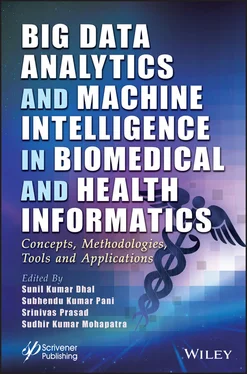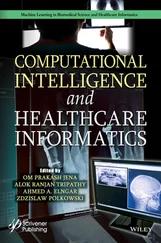Currently, healthcare systems rely on a patchwork of disparate and continuous monitoring devices that use single physiological waveform data or discretized vital information to generate alerts in the event of over events [7]. However, such uncomplicated approaches to developing and implementing alarm systems are inherently unreliable, and their sheer volume may result in “alarm fatigue” for care givers and patients alike [8, 9]. In this context, the capacity for new medical knowledge discovery is constrained by prior knowledge that has frequently fallen short of fully exploiting high-dimensional time series data. In [10] Jphan et al . suggested the reason these alarm mechanisms frequently fail is that they rely on isolated sources of information and lack context regarding the patients’ true physiological conditions from a broader and more comprehensive perspective. As a result, improved and more comprehensive approaches to studying interactions and correlations between multimodal clinical time series data are required. This is critical because research consistently demonstrates that humans are unable to reason about changes affecting more than two signals [11, 12].
Medical images are a valuable source of data that are frequently used for diagnosis, treatment evaluation, and planning [13]. Computed Tomography (CT), Magnetic Resonance Imaging (MRI), Photoacoustic Imaging (PI), Molecular Imaging (MI), Positron Emission Imaging (PEI), and Sonography are all examples of established clinical imaging techniques. However, medical image data will often have up to hundreds of megabytes (e.g., up to 2,500+ scans [14]) for one study (in one study, for example, histology data), or even thousands of megabytes (a large number of scans in a thin-slice CT study, e.g., proctology). Data needs a large storage area to be held for extended periods of time. While any decision support needs to be completed on the fly, they must be quick and precise algorithms in order to have practical benefits. Even though these patients’ overall and individual medical data are often acquired for each of giving additional information, as well as for their diagnoses, prognoses, treatment procedures, and outcomes, the development of storage and methodologies capable of gathering and maintaining relevant medical data is additionally challenged.
Despite current healthcare systems’ enormous expenditures, clinical outcomes remain sub-optimal, particularly in the United States of America, where 96 people per 100,000 die annually from treatable conditions [15]. A significant contributor to such inefficiencies is healthcare systems’ inability to effectively collect, share, and use more comprehensive data [16]. This creates an opportunity for big data analytics to play a more significant role in assisting the exploration and discovery process. Improving care delivery, assisting in the design and planning of healthcare policy, and providing a means of comprehensively measuring and evaluating the complicated and convoluted healthcare data. More importantly, the adoption of insights gleaned from big data analytics has the potential to save lives, improve care delivery, expand access to healthcare, align payment with performance, and aid in containing the perplexing growth of healthcare costs.
1.4 Healthcare as a Big Data Repository
Healthcare is a multi-dimensional system established with the sole aim for the prevention, diagnosis, and treatment of health-related issues or impairments in human beings. These are the main parts of a healthcare system; you have the medical personnel (doctors and nurses), which supports the healthcare facilities (clinics and hospitals for delivering medicine and technologies), and then you have financing supporting them. The physicians who practice in different areas of healthcare, such as dentistry, midwifery, and psychology are health professionals known as so-aspirants. Since there are so many issues with healthcare, it depends on the level of urgency and extent of treatment to expand. The professional first; their clientele receives it from a variety of treatment options, complex and invasive conditions, both from non-professional physicians and private hospitals, and as well as from the general medical community (non-specialized as well as well as private) (quaternary care) [17]. A doctor, nurse, researcher, radiologist, and lab technician are all needed to have separate needs and are held responsible for a number of different types of information. For example, that of patient history (diagnosis and prescriptions), other medical and clinical (data obtained from imaging and laboratory tests), and personal history (all those that may apply), data on other medical issues as opposed to previous record keeping methods that typically utilized handwritten or typed case notes, in which these medical records were stored. This earlier method was not done, this could be compared to the results of a medical tests which are traditionally kept in an inadequate electronic systems. For reference, an ancient papyrus from Egypt suggests that this was standard practice even a figure in the time of 1600 BC [18]. In Stanley Reiser’s opinion [19], the medical case histories do an excellent job of recording everything in relation to the story of the patient, the family, and the physician, while preserving the dynamics of the illness.
Although digital systems have long been commonplace in healthcare, the implementation of more complex medical records is considered modern—a “means” today for generating an expanded comprehension of the available data sets and further learning about that health and illness. In 2003, the Institute of Medicine, a division of the National Academies of Sciences, Engineering, and Medicine, coined the term “Electronic Health Records” to refer to records maintained for the purpose of improving the healthcare sector for the benefit of patients and clinicians. As defined by Murphy, Hanken, and Waters, Electronic Health Records (EHRs) are computerized medical records for patients that contain information about an individual’s past, present, or future. Physical/mental health or condition that is stored in electronic systems that are used to capture, transmit, receive, store, retrieve, link, and manipulate multimedia data for the primary purpose of providing healthcare.
1.5 Applications of Healthcare Big Data
There are new applications that can make use of big data sets to explore various avenues of knowledge, and there are methods to refine healthcare delivery to be derived from these discoveries (crucial uses, noxerous applications). Some critically important ones include the application of public health, clinical use, medicine based on scientific evidence, and medical diagnosis, and verification, analysis, and patient monitoring. These are the various healthcare frameworks and healthcare storage systems that were briefly explained to explore applications of healthcare big data below.
1.5.1 Electronic Health Records (EHRs)
Electronic Health Records (EHRs) is by far the most prevalent use of big data in medicine. Each patient has his or her own digital record, which contains demographic information, medical history, allergies, and laboratory test results, among other things. Records are shared securely via information systems and are accessible to both public and private sector providers. Each record is composed of a single modifiable file, which enables doctors to make changes over time without incurring additional paperwork or risk of data replication.
Additionally, EHRs can generate alerts and reminders when a patient requires a new lab test or track prescriptions to ensure the patient is following doctors’ orders. While EHRs are an excellent idea, many countries have yet to fully implement them. The United States has made significant strides, with 94% of hospitals adopting EHRs, according to this HITECH research, but the European Union continues to lag behind. However, an ambitious directive being drafted by the European Commission is intended to alter that situation.
Читать дальше












